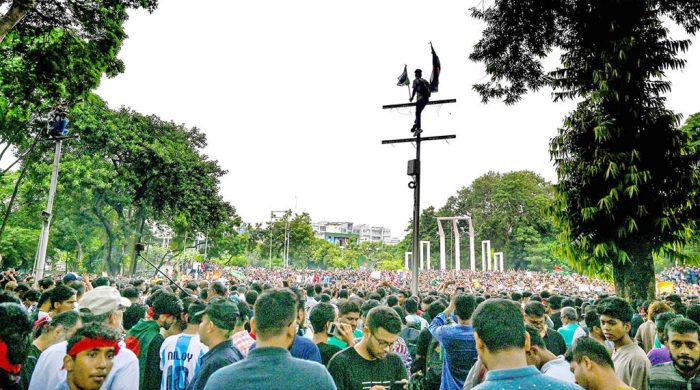Land ports in connectivity, trade, growth

- Update Time : Tuesday, June 14, 2022
- 89 Time View

THE Bangladesh Land port Authority was set up in 2001 with the enactment of the Bangladesh Land Port Act 2001 by the parliament. So, the authorities, as an organisation, are only two decades old. Nonetheless, in such a span, it has put its footprint strongly on the economic development of the country by facilitating trade, fostering connectivity and stimulating growth. This is done by developing infrastructure, introducing technology and by encouragimg automaton for a smooth movement of vehicles and passengers. This created a multiplying effect on the growth of trade in the region, especially with India and other neighbouring countries such as Nepal and India. Over the years, a growing volume of trade between Bangladesh and India bears testimony to this.
The agency started its operation only with Benapole and Sonamasjid land ports, but with the passage of time, more ports came under its wing. The agency has 24 declared land ports, of which 12 are in operation, eight are being readied for operation and rest four would be developed based on the need.
Land ports of Bangladesh play important roles by facilitating the movement of goods and passengers to and from Bangladesh to India and other neighbouring countries. Because of Bangladesh’s unique geographical position with India, land ports bring opportunities for cross-border trade with neighbouring countries. Physical proximity has enabled neighbouring countries to trade with Bangladesh in an affordable, convenient, and efficient way. Geographically, India surrounds Bangladesh on the north, north-east and west and Myanmar on the south-east. Bangladesh-India land border is the fifth longest in the world, which brings opportunity for both the countries to set up land customs stations, ports and international passenger terminals for trade, the movement of vehicles and passengers. This strategical position and physical proximity of Bangladesh and India make it easier for both the countries to undertake mutually beneficial programmes and cooperate in border trade.
It has been observed that Bangladesh’s land ports bring varying degrees of benefits to the economy of Bangladesh. By supporting numerous economic activities in the bordering districts, land ports helped to flourish small traders, tea stalls, saloons, garages, parking facilities and many more. As supplier of jobs, land ports support social functions, too, in terms of the creation of clubs, associations, gathering points, mosques, etc.
With a higher movement of goods and passengers year on year, land ports are readied with more infrastructure, provisions, and associated services. It is now agreed on by policymakers and stakeholders that the growth and development of land ports lead to greater trade activity, increased supply, job creation, and reduced prices for commodities. All over the world, it is acknowledged that the gross domestic product is significantly affected by the ability of companies at exporting goods and services regionally and globally. So, effective transport facilities in land ports have the potential to significantly increase economic growth and success of nations. It is against this backdrop, land ports in Bangladesh are important establishments to boost total trade (export and import), to flourish uninterrupted regional connectivity and to support higher GDP for the country.
Inter-regional connectivity
BANGLADESH’S geographical location make it an ideal country to establish connectivity with South Asian nations. Its sea ports, land ports and airports are located strategically to foster interregional connectivity and reap benefits from this connectivity. It is now admitted that national and regional connectivity in South Asia helps to drive socio-economic growth by creating economic opportunities for countries and poorer areas. Evidence also shows that an improved connectivity within the country between lagging and prosperous regions can help to promote the transformation of regions that lag behind. As this is true within the country, so it is in the inter-regional context, where land is locked or inaccessible because of difficult terrains.
Bangladesh and India have a land boundary of 4,096 kilometres. This long border boundary created an opportunity as well challenges for both the countries. In terms of opportunity, it created the opportunity for Bangladesh and India to establish road and railway links to transport and transit goods between India and Bangladesh and other neighbouring countries, including Nepal and Bhutan. In the border area where vehicles and passengers pass through one country to another, land ports are built. These land ports in the border area make trade between Bangladesh, India, Nepal, and Bhutan much easier, less costlier and predictable. Studies undertaken by the World Bank and the Asian Development Bank show that there is ample opportunity for adjoining countries to commence trade amongst themselves in a more efficient, seamless, and hassle-free way.
A recent World Bank report also confirms that a seamless transport connectivity between India and Bangladesh has the potential to increase national income by as much as 17 per cent in Bangladesh and 8 per cent in India. Same report highlights that transport connectivity between Bangladesh and India could increase export even further, yielding a 297 per cent increase in Bangladesh’s exports to India and a 172 per cent increase in India’s exports to Bangladesh. Another study conducted by the Asian Development Bank estimates that the improvement of priority regional transport corridors in Bangladesh could facilitate the movement of about 18 million tonnes of freight in Bhutan, India and Nepal.
In fact, Bangladesh has the potential to become a major transport and transshipment hub in the subregion. Keeping this in mind, Bangladesh, Bhutan, Indian and Nepal have signed the Motor Vehicle Agreement to facilitate cargo and passenger movement in the BBIN subregion. But because of lukewarm support and many bottlenecks from other stakeholders, the agreement is yet to see the light of the day.
To strengthen interregional connectivity, the Bangladesh agency has undertaken a good number of projects with the support of the World Bank, the Asian Development Bank and on its own financing. The most notable among them are the ADB-supported South Asia Sub-Regional Economic Cooperation project. This SASEC project aims at boosting intra-regional trade in the SASEC subregion by improving cross-border connectivity, by facilitating structures and system development in the regional and national SASEC transport projects. Under this project, the Bangladesh agency is going to develop two important land ports of Bangladesh — Tamabil and Akhaura. The Indian ICP against these two land ports are Dawki and Agartala. Once facilities are developed, these two land ports will contribute immensely to the connectivity between people and business communities of the two countries, ensure a seamless movement of cargo and passengers and help to flourish the hinterland economy of both the countries. This project has recently been approved.
Under the WB Bangladesh Regional Connectivity Project (Phase-1), the land port authorities have selected three land ports — Ramgarh, Sheola and Benapole — for refurbishing and developing new infrastructure, streamlining border management, securing borders and ports, and harmonising system with the Indian ICPs. But as ill luck would have it, the Bangladesh Land Port Authority is yet to get clearance from India’s Border Security Force to start the work there. Although NOA has been issued by the Land Port Authority to the contractor, the latter is yet to start the work with a clearance from the Border Security Force stationed at the border of point of Sabrum and Sutarkandi, situated against Bangladesh land ports Ramgarh and Sheola. Another flagship project, Bangladesh Regional Trade Facilitation Project, also supported by the World Bank, is about to be approved by the National Economic Council. This milestone project will have an immense impact on the performance of the Land Port Authority, especially in the creation of infrastructure, delivering services, easing cross-border movement through automation and the use of modern technology in the four land ports — Bhomra, Burimari, Benapole and Bholaganj.
Once the Bangladeshi land ports are fully developed and functional, they will act as a hub and economic corridor for passenger and vehicle movement from Bangladesh to India and the other way round. The ports will also help Nepal and Bhutan to ferry their goods to and from Bangladesh using the Indian land corridor. As the ports are developed keeping in mind the future need of transit and transshipment, they will act as a bridge of connectivity and friendship between people of Bangladesh and India and other neighbouring countries such as Nepal and Bhutan.
The long-awaited Padma Bridge is going to be inaugurated on June 25. It is expected that this bridge will create immense opportunity for India to bring goods using this bridge. Vehicles cleared either at Benapole or Bhomra or Hili or Banglabandha or Sonamosjid will now be able to use this bridge. This bridge is going to reduce the distance and transaction cost for carrying goods and passengers from Benapole, Bhomra or any other western or northern land ports of Bangladesh to Dhaka or further. If India wants to transit goods from Bangladeshi land ports to Agartala, Dawki or Sutarkandi, this bridge will be of great help for easy and less costly transport. The north-eastern hilly states of India will benefit heavily from this connectivity. Passenger vehicles will be able to ferry between the two countries with less time and cost. This bridge will surely create multiplying effect on the economy of Bangladesh as well as in the region, which will allow land ports of Bangladesh to get ready for the surge of passengers and goods to be ferried.
It is evident that Bangladesh will benefit from this connectivity and integration. Especially south-western districts of Bangladesh will enjoy larger gains in real income. India states bordering Bangladesh such as Assam, Meghalaya, Mizoram, and Tripura in the northeast, and West Bengal in the west. Indian states further away from Bangladesh such as Uttar Pradesh and Maharashtra would also gain huge economic benefits from the seamless connectivity. This will have spillover effects on Nepal and Bhutan, too. In fact, regional connectivity offers the promise of long-term sustainable and inclusive growth in the region. To reap the benefits, both Bangladesh and India must work together and mend the differences at the earliest.
Promotion of trade
TRADE between nations has always made a significant contribution in terms of increasing wealth among the world populations and there is strong correlation between trade and gross domestic product. It is true that ports are important and necessary component in facilitating trade. In the case of Bangladesh and India, land ports are the primary conduit for bilateral trade and important for the growth of economies. The land ports are gateway to around 40 per cent of trade by volume between Bangladesh and India.
Geographically, Bangladesh’s location makes it a strategic gateway to India, Nepal, Bhutan, and other East Asian countries. Bangladesh can also become an economic powerhouse by improving regional trade, transit and logistic networks. But because of different tariff and non-tariff barriers, this benefit is still a distant dream. Added to this is the malaise of inadequate infrastructure, poor road network, manual and paper heavy checking system, different office timing for the ports. Trade between Bangladesh and India accounts for only about 10 per cent of Bangladesh’s trade and a mere 1 per cent of India’s trade. Whereas, in East Asian and Sub-Saharan African economies, intraregional trade accounts for 50 per cent and 22 per cent of total trade. Hence, the promotion of trade for mutual benefits of the people of Bangladesh and India is a must.
In 2019, Bangladesh exported goods valued at $47.2 billion and imported goods valued at $55.6 billion. The top origin countries for imports into Bangladesh are China ($17.3 billion), India ($8.24 billion), Singapore ($2.96 billion), Malaysia ($2.33 billion) and Indonesia ($1.91 billion). The top destination countries for exports of Bangladesh are the United States ($6.86 billion), Germany ($6,69 billion), United Kingdom ($3,92 billion), Spain ($6.86 billion) and France ($3.33 billion). It is evident from the export figure that although Bangladesh is the second-largest importing country from India, in term of Bangladeshi exports to India, it is very negligible. The export-import figure collected from land ports of Bangladesh bears testimony to this. Statistics show that total import of Bangladesh are 9 to 10 times higher than total export of Bangladesh to India. India imports around $400 billion worth of commodities from the global market but Bangladesh’s contribution to the the big import market is very small, even not worth $1 billion. Bangladesh’s trade with India is only less than a half of its current potential.
On the other side, if we look at Nepal and Bhutan, we see that India is the market for approximately 70 per cent and 90 per cent of Nepal and Bhutan’s export. Since the 2000s, India’s trade with Nepal increased from $0.3 million in 2000–2001 to $7.9 billion in 2019–20. Furthermore, approximately 75 per cent of Nepal’s and 100 per cent of Bhutan’s global trade transits through India. Various tariff and non-tariff barriers, transport, and clearance delay along with infrastructure deficit particularly, the harmonisation of regulations and customs procedures in designated border posts create obstacles and account for this poor performance.
However, land ports of Bangladesh could be gateway for exports of Bangladeshi goods to the ever-expanding Indian market. Especially, Bangladeshi goods can reach Indian seven eastern states easily where difficult terrains have impeded communication and resultantly increased costs for Indian commodities to reach the far-flung states. Bangladesh’s five to seven land ports are geographically located to serve these states in a better way. In fact, Bangladesh’s Akhaura, Sheola, Tamabil, Bibirbazar and Bilonia to some extent serving this need. But this is not to the optimum because of some impediments.
Land ports in economic development
THERE is a strong correlation between trade growth, trade facilitation and economic growth. It has been pointed that expansion in trade because of enhanced trade facilitation could lead to increases in the per capita GDP in Asia and Pacific countries by about 2.5 per cent. Ports play an important role as a gatekeeper and facilitator in this case.
Evidences of economic impact of land ports in terms of aggregate income generation, value addition and employment generation are convincing. There is no denying the fact that land ports of Bangladesh are playing an important role in the economy of Bangladesh. In the past two decades, the Bangladesh Land Port Authority has contributed exceptionally to the development of the country, especially by generating revenue and employment, fostering small businesses, flourishing growth centres, empowering men, and women in the locality where it operates. Statistics show that the agency has earned Tk 1,370 crores in revenue and deposited to the government exchequer an amount Tk 50 crore until 2021. It has a deposit of around Tk 300 crores in different banks as short- and long-term credits. It has also created job for more than 10,000 labourers in land ports and nearly four hundred people work in the Bangladesh Land Port Authority permanently, with a good number of them being women.
Land crossings account for nearly 40 per cent of all bilateral trade between Bangladesh and India and play an important role in strengthening trade ties while reducing costs. The efficient movement of people and goods between the two countries is essential for reducing the costs of trade, fostering economic synergies to support growth, and driving inclusive socioeconomic development across the SASEC subregion. Goods travel between Bangladesh and India by road, railway, air, maritime, and inland waterways, with 38.5 per cent of all trade in 2018 having crossed by land.
Most of the goods travelling from Bangladesh to India move by land, with 70.4 per cent of exports to India having been transported by road or rail. This is to confirm that with the growth of trade and trade facilitation, economic development follows logically. In the case of the Asia and Pacific region, it is observed that expansion of trade and trade facilitation increased gross domestic product per capita by about 2.5 per cent.
Similarly, it is also observed that decreasing direct and indirect trade transaction costs by 1 per cent can result in an average of 0.25–0.4 per cent increase in gross domestic product. This is evident that improvement in trade facilitation can potentially generate not only more trade, but also raise the national gross domestic product. The raw materials that are needed for industry is cleared through the land ports, used at the local factories and industries and after adding value, the final products are then exported to the European Union or the United States.
Usually, the border area of the country is mostly dull and moribund, having no industry, no market or growth centres. So, the setting up of land ports in the border area creates lot of activity in the locality and the region. Gradually, it changes the socio-economic condition of the area completely. Once out of touch with modernity, land ports completely change the landscape of that area with small businesses. The socio-economic impact of the land ports is immense and far-reaching on the economy and lives of the people in Bangladesh. So, there is more demand for more land ports in other remote areas of Bangladesh where India has LC stations or similar land ports.
It shows clear that land ports play an important role in the trade facilitation and economic growth of Bangladesh. Whatever the percentage of growth is contributed by land ports mostly come from the export and the import of goods and the provisioning of logistic services. Alongside this, the generation of employment opportunities and the addition of values in the vicinity also contribute to this economic growth. It is now unanimously agreed on by policymakers and stakeholders that land ports in Bangladesh have a strong impact on the trade, regional growth, and people to people connectivity. Situated in the border area far from the centre, the land ports are seen as structuring elements within the surroundings by promoting business, small trades, banks, offices, and many other supporting activities and organisations.
It is in this way, land ports work as pillars to the development of the economy and connectivity of the region. It is observed that land port infrastructure stimulates the process of economic growth and this is true that this growth is contingent on production capacity, skills and logistical prowess of the ports. Fresh investment in ports through government and donor support helps to achieve this goal. Through the export and te import of goods and services, the supply of ancillary services, the development of supporting railway and road infrastructure, land ports of Bangladesh serve to a great extent the bigger goal of achieving the vision of a a prosperous and developed nation by 2041.
It is also acknowledged that land ports of Bangladesh have great potential to contribute more to the socio-economic development of Bangladesh but lack of big investments in infrastructure and lagging in the use of technology and slow introduction of automated border system, lack of coordination among the agencies have a detrimental effect on the overall performance of the land ports. The Perspective Plan of Bangladesh (2021–2041) aims at enhancing export competitiveness by addressing cross-cutting issues.
To gain from the bilateral or multilateral trade, to ensure interregional connectivity and economic growth, land ports of Bangladesh must be readied to streamline processes, set congenial policy framework and harmonise operating system. In an automated, digitised and harmonised border management system, trading countries will be able to benefit to the optimum as this system will reduce the transaction cost and waste of time. The Bangladesh Land Port Authority is looking forward to chartering a journey where border trade will be paperless, seamless and hassle-free; and participating countries will be able to reap the benefits by trading with each other efficiently and confidently.
Md Alamgir is chairman of the Bangladesh Land Port Authority.



















